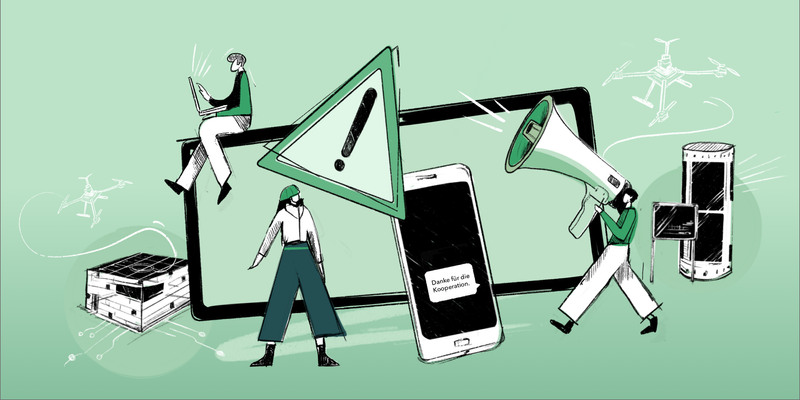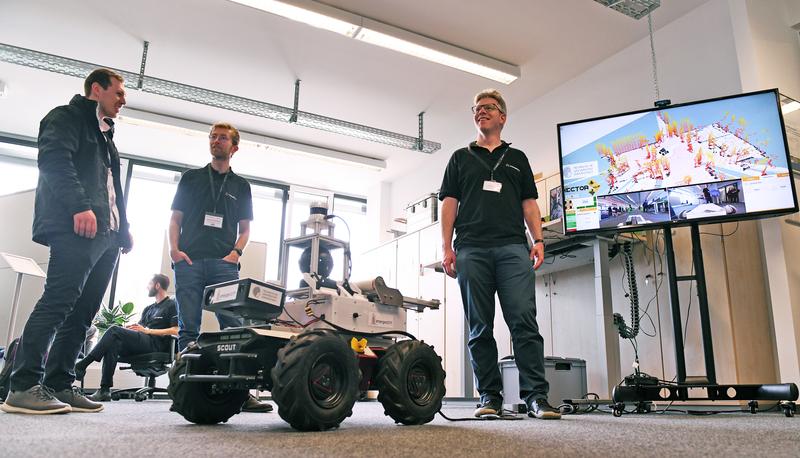Jana trudged across the bone-dry street in her rubber boots and rang the bell. It took almost a minute before an answer sounded from the intercom.
“Yes?”
“This is the fire department. This area is being evacuated due to the danger of flooding. Didn’t you get the warning?”
“I did, but I’m busy right now. Just leave me here.”
Jana wanted nothing more than to bang her head against the door. “I can’t leave you here. Your apartment is not on the exemption list. Do you have -“
Jana broke off. The crackling on the line was unmistakable. She was literally talking to a wall.
She turned around. Tobias was standing across the street, and he knew immediately what was going on. His eyes focused on the display of his augmented reality glasses as he spoke into his headset. A moment later, Jana’s earbuds sounded.
“Jana?”
“Yes?”
“Can you come to the situation center?”
Jana looked up at Tobias, who gestured in front of his glasses, and felt like a traitor even as she agreed. “I’ll be right there.”
She trudged back to the fire engine and changed her rubber boots for sneakers. As soon as she finished, Tobias turned around the corner of the vehicle.
“Felix and his team are coming to help us. We’re supposed to do the rescue -“ He paused when he noticed the shoes.
“Sorry,” Jana said. “I’ve been called to the situation center.”
Tobias actually managed a smile. “Lucky you. Try to talk to them about acceptance, will you?”
Jana grimaced and clapped him on the shoulder. “You got this. Not long now and it’ll be over.”
With that, she left him and hurried down the street. It was a gray day that promised rain but the red warning light of the smart lanterns had been bathing the city in a kind of hazy sunset for nearly four hours. Most of the lights were dimmed, the traffic lights were off, and traffic consisted mostly of bicycles and cubicles. The electric mini-cars had been connected to emergency power to provide an alternative to the bus shuttle services while traffic was limited. The availability of electricity during a crisis was still limited, but the available options were constantly expanding.
Strategically located right next to the bikesharing station stood one of the many modernized advertising pillars that were used to inform the entire population during a crisis. They were primarily intended to reach vulnerable groups but have long been used outside of crises as well, serving anyone who passed by. Jana glanced at it before unlocking a bicycle. The information was still the same as before: The notice about the power outage, evacuation instructions due to the risk of flooding, and general information about available transportation and places to get help. There was also a complaints line, which had broken down during earlier experiments because there had been too many complaints. Back then, perceptions of crises had been associated primarily with uncertainty and fear. That had changed since crisis communication focused on cooperation and empowerment.
Jana swung onto her bike and cycled the short distance to the situation center. The exercise felt good, and she had to admit that, this time, it had actually gone really well - as far as one could speak of something going well in crises. Of course, they had to struggle with the acceptance of some people, but those were isolated cases. Most of the evacuees had set up a kind of party tent within an hour via requests in the neighborhood app and they had poured Jana and Tobias mulled wine when they had stopped by for a situation briefing. Non-alcoholic, of course; they were on duty, after all. Also, school classes were involved in the supply, because the children had years since translated the requests for help in the app into a kind of playful competition. No sooner was a request posted, asking if anyone had some fresh water, than a dozen children immediately responded and, after a few minutes, proudly presented their own supply to those seeking help.
So why this callback to the situation center now? Was there a problem she didn’t know about?
Jana left the bike, walked past the information display outside the situation center, that copied the information from the advertising columns, and a short time later entered the room that was the physical coordination center for crisis management. Two members of the management team were in charge of the computers that were collecting data from the entire city through their sensor network, analyzing it and contributing whatever was technically possible to solve the crisis. Computers controlled the drones that maintained communications and sent back a situation report, assisted by the robotic scouts on the ground. Computers reported problem spots where THW, firefighters or police were needed, and they optimized the distribution of resources. With their help, it was possible to maintain an overview in the midst of the information flood during a crisis and, above all, to separate the important from the unimportant information.
Gerrit and Julia looked up and waved at her. Gerrit was sitting in front of the screens that were displaying the analyses and decisions. Julia stood at the table that showed the supply network of the entire city.
Jana joined her and skimmed the display. Usually, the utility grid was a sea of green dots with individual red, orange, or yellow dots when local outages occurred. Now it was a patchwork of green, yellow, orange and red dots.
Jana tilted her head. “The water was turned off in the north?”
She had spent the time since the evacuation in the south of the city, where this warning had not arrived. That explained some of the requests for fresh water, though.
Julia nodded. “For the last half hour.”
“Probably they think it appropriate, combined with the flooding,” said Gerrit.
Jana shrugged. “They are not wrong.”
She was about to ask why they had called her when Sven, the head of the crisis management team, walked through the door. Almost at the same time, Jana’s smartwatch lit up and Gerrit sat back with a sigh.
“That’s it.”
Jana glanced at her smartwatch. The all-clear had just come in via cell broadcast. She thought of Tobias. If Felix and the others hadn’t hurried too much, they had been spared the final rescue simulation for the day.
She looked down at the supply net. It still showed a lot of red dots in the water supply area and the power supply consisted of green dots only where the eHubs – energy self-sufficient houses whose concept had emerged from a research project years ago – fed their electricity into the grid and supplied the yellow dots with power. The orange buildings ran on their own or on emergency power. A single red dot was alarming. One building had no power at all.
Julia noticed Jana’s look and waved it off. “That’s a display error. They generate their own electricity since a short time ago.”
Even as she spoke, all the colors abruptly turned green.
Jana nodded and looked over at Sven, who was working at the Federal Agency for Technical Relief. “You need us for the analysis?”
“What do you think?” Gerrit swiveled around in his chair and grinned. “The others will be here soon. Then there will finally be something going on here, as well. Even more so when the mayor comes by later to assess our work.”
Jana nodded and for a fleeting moment she wished she had stayed for the rescue simulation. But then she told herself she wasn’t alone in this.
While they waited for the feedback from the complaints department and the other members of the crisis management team, Gerrit volunteered to make some tea. Jana hastily sent a request to everyone asking for feedback for today. The computer decided randomly who was to become the expert advisor participating in the analysis, and she had been picked for the first time. But she would be prepared.
The learning phase was the most important phase of the day. This is where everyone sat together, with the computer’s results and suggestions for improvement, and discussed what they could improve next time, what had worked and what hadn’t. Thus, technology, emergency personnel, and the public learned collectively what the best response to a crisis was and how best to manage it so that it was a smaller problem next time or when an actual emergency struck. They could not eliminate the problems posed by crises. But they could learn to face them without fear. That was what they did during this day, which had started out as a warning day back in 2020 and had gone so horribly wrong in the beginning.
Jana’s smartwatch lit up. Tobias was inviting her to a party with the evacuees once they were done with the analysis. Jana sent him a thumbs up. Cell service was apparently working again for private messages. Normality was restored. The streetlights glowed white and the last cell broadcast message transmitted to the advertising pillars read: “Thank you for your cooperation during this year’s crisis practice day.”
by Annemarie Mattmann for LOEWE emergenCITY



